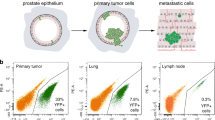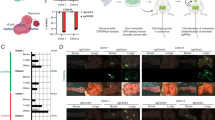Abstract
Metastasis represents the ultimate target in cancer therapy as this complex biological process is the direct cause of mortality for a variety of human malignancies. The current high level of mortality from prostate cancer results in large part from the inexorable growth of overt or occult metastasis present at the time of diagnosis. Currently, there are no curative therapies for metastatic prostate cancer. To better understand the metastatic phenotype in prostate cancer, we developed a strategy to identify mRNAs that are expressed differentially in cell lines derived from primary versus metastatic mouse prostate cancer using differential display-PCR. In using this system a number of metastasis-related sequences were identified including a cDNA that encodes caveolin-1. Caveolin-1 was found to be overexpressed not only in metastatic mouse prostate cancer, but also in human metastatic disease. Recent studies have indicated that suppression of caveolin-1 expression induces androgen sensitivity in high caveolin-1, androgen-insensitive mouse prostate cancer cells derived from metastases. Conversely, overexpression of caveolin-1 leads to androgen insensitivity in low caveolin, androgen-sensitive mouse prostate cancer cells. Caveolin-1, therefore, is both a metastasis-related gene as well as a candidate androgen resistance gene for prostate cancer in man. Interestingly, recent studies also point to a potential role for caveolin-1 in the resistance of various malignancies to multiple antineoplastic agents. The linkage of caveolin-1 expression with the androgen-resistant phenotype in prostate cancer and the multidrug resistance phenotype in various solid tumors establishes a novel paradigm for understanding these clinically important and now potentially related processes in malignant progression.
Similar content being viewed by others
References
Thompson TC, Park SH, Timme RL, et al. Loss of p53 function leads to metastasis in ras + myc-initiated mouse prostate cancer. Oncogene 1995; 10: 869-879.
Hall SJ, Thompson TC. Spontaneous metastatic activities but not experimental metastatic activities differentiate primary tumor-derived vs. metastasis-derived mouse prostate cancer cell lines. Clin Exp Metastasis 1997; 15: 484-493.
Yang G, Truong LD, Timme TL, et al. Elevated expression of caveolin is associated with progression in prostate and breast cancer. Clin Cancer Res 1998; 4: 1873-1880.
Harter T, Simons K. Caveolae, DIGs, and the dynamics of sphingolipid-cholesterol microdomains. Curr Opin Cell Biol 1997; 9: 534-542.
Nasu Y, Timme TL, Yang G, et al. Suppression of caveolin expression induces androgen sensitivity in metastatic androgen insensitive mouse prostate cancer cells. Nature Med 1998; 4: 1062-1064.
Lavie Y, Fiucci G, Lisrovitch M. Up-regulation of caveolae and caveolar constituents in multidrug-resistant cancer cells. J Biol Chem 1998; 273: 32380-32383.
Huang C-P, Galbati F, Volonte D, Horwitz SB, Lisanti MP. Upregulation of caveolin-1 and caveolae in taxol-resistant A549 cells. FEBS Lett 1998; 439: 368-372.
Engelman JA, Wykoff CC, Yasuhara S, et al. Recombinant expression of caveolin-1 in oncogenically transformed cells abrogates anchorage-independent growth. J Biol Chem 1997; 272: 16374-16381.
Lee SW, Reimer CL, Oh P, Campbell DB, Schnitzer JE. Tumor cell growth inhibition by caveolin re-expression in human breast cancer cells. Oncogene 1998; 16: 1391-1397.
Kyprianou N, Isaacs JT. Biological significance of measurable androgen levels in the rat ventral prostate following castration. Prostate 1987; 10: 313-324.
Egawa S, Kadmon D, Miller GJ, Scardino PT, Thompson TC. Alterations in mRNA levels for growth-related genes after transplantation into castrated hosts in oncogene-induced clonal mouse prostate carcinoma. Mol Carcinog 1992; 5: 52-61.
Hiramatsu M, Kashimata M, Minami N, et al. Androgenic regulation of epidermal growth factor in the mouse ventral prostate. Biochem Int 1988; 17: 311-317.
Shabsigh A, Chang DT, Heitjan DF, et al. Rapid reduction in blood flow to the rat ventral prostate gland after castration: preliminary evidence that androgens influence prostate size by regulating blood flow to the prostate gland and prostatic endothelial cell survival. Prostate 1998; 36: 201-206.
Tenniswood MP, Montpetit ML, Leger JG, et al. Epithelial-stromal interactions and cell death in the prostate. In: Farnsworth WE, Ablin RJ, eds. The Prostate as an Endocrine Gland. Boca Raton FL: CRC Press, 1990: 187-204.
Coffey DS. Endocrine control of normal and abnormal growth of the prostate. In: Rajfer J. ed. Urologic Endocrinology. Philadelphia, PA, WB Saunders Co., 1986: 170-195.
Kyprianou N, English HF, Isaacs JT. Activation of a Ca++-Mg++-dependent endonuclease as an early event in castration-induced prostatic cell death. Prostate 1988; 13: 103-118.
Martikainen P, Isaacs JT. Role of calcium in the programmed death of rat prostatic glandular cells. Prostate 1990; 17: 175-188.
Shaul PW, Anderson RGW. Role of plasmalemmal caveolae in signal transduction. Am J Physiol 1998; 275 (Lung Cell Mol Physiol 19): L843-L851.
van Veen HW, Konings WN. Multidrug transporters from bacteria to man: similarities in structure and function. Semin Cancer Biol 1997; 8: 183-191.
Fielding CJ, Bist A, Fielding PE. Caveolin mRNA levels are upregulated by free cholesterol and down-regulated by oxysterols in fibroblast monolayers. Proc Natl Acad Sci USA 1997; 94: 3753-3758.
Okamoto T, Schlegel A, Scherer PE, Lisanti MP. Caveolins, a family of scaffolding proteins for organizing “preassembled signalling complexes” at the plasma membrane. J Biol Chem 1998; 273: 5419-5422.
Vairo G, Innes KM, Adams JM. Bcl-2 has a cell cycle inhibitory function separable from its enhancement of cell survival. Oncogene 1996; 13: 1511-1519.
Huang DCS, O'Reilly LA, Strasser A, Cory S. The antiapoptosis function of Bcl-2 can be genetically separated from its inhibitory effect on cell cycle entry. EMBO J. 1997; 16: 4628-4638.
Author information
Authors and Affiliations
Rights and permissions
About this article
Cite this article
Thompson, T., Timme, T., Li, L. et al. Caveolin-1, a metastasis-related gene that promotes cell survival in prostate cancer. Apoptosis 4, 233–237 (1999). https://doi.org/10.1023/A:1009612708099
Issue Date:
DOI: https://doi.org/10.1023/A:1009612708099




